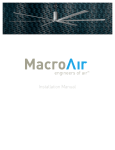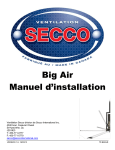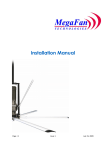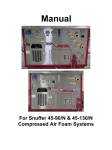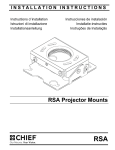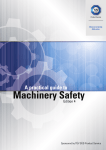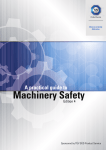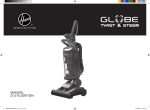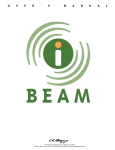Download Installation Manual
Transcript
……………………… Owners Manual ... Installation Manual Page 2 Installation Manual Contents Anatomy of a Fan --------------------------------------------------------------------------------------------------- 4 Check Your Shipment, What's Included For 10 & 6 Blade Fans --------------------------------------------------- 5 What You Need To Get Started ------------------------------------------------------------------------------------- 5 Check Your Shipment, What’s Included For eco6 Guard Fan --------------------------------------------------- 6 1 Important Information, PLEASE READ FIRST ---------------------------------------------------------------------------------- 7 1.1 Key Safety System Components -------------------------------------------------------------------------------- 7 1.2 Placement and Spacing ---------------------------------------------------------------------------------------- 7 1.3 Fan Clearance Drawing ---------------------------------------------------------------------------------------- 7 1.4 Mark Floor To Alert Personnel ----------------------------------------------------------------------------------- 7 1.5 Sprinkler Systems and Fan Placement -------------------------------------------------------------------------- 8 1.6 Locating Control Panels ----------------------------------------------------------------------------------------- 8 1.7 Connecting Fans to Remote Controls -------------------------------------------------------------------------- 8 1.8 Shielded Motor Cable ------------------------------------------------------------------------------------------- 8 1.9 Check Federal, State and Local Codes ----------------------------------------------------------------------- 8 2.0 General Mounting Considerations ----------------------------------------------------------------------------- 8 2.1 Weight ------------------------------------------------------------------------------------------------------------ 9 2.2 Torque ------------------------------------------------------------------------------------------------------------ 9 2.3 Safety Cable ----------------------------------------------------------------------------------------------------- 9 2.4 Close Clearances ----------------------------------------------------------------------------------------------- 9 2.5 Guy Cables ------------------------------------------------------------------------------------------------------ 9 2.6 Guards ----------------------------------------------------------------------------------------------------------- 9 2.7 Universal Mounting Hardware -------------------------------------------------------------------------------- 10 2.8 Maintenance -------------------------------------------------------------------------------------------------- 10 Control Panel ---------------------------------------------------------------------------------------------------------------------------- 10 Power Unit --------------------------------------------------------------------------------------------------------------------------------- 10 Mounting Hardware ------------------------------------------------------------------------------------------------------------------- 10 2 Installation Procedures ---------------------------------------------------------------------------------------------------- 11 MacroAir Technologies Inc. www.macro-air.com Toll Free: 866-668-3247 Build: January 9 2009 Page 3 Step 1, Install Mounting Hardware ------------------------------------------------------------------------------- 11 Step 2, Attach Power Unit To Mounting Hardware -------------------------------------------------------------- 12 Step 3, Attach Safety Cable -------------------------------------------------------------------------------------- 12 Step 4, Mount The Motor Control Panel -------------------------------------------------------------------------- 12 Step 5, Mount Remote Switchbox -------------------------------------------------------------------------------- 13 Step 6, Make Control Circuit Connections ---------------------------------------------------------------------- 13 Step 7, Make Motor Lead Connections -------------------------------------------------------------------------- 13 Step 8, Install Guy Wires ------------------------------------------------------------------------------------------- 15 Step 9, Install Fan Blades, Blade Safety Links, & Safety Link Extenders ---------------------------------------- 16 Step 10, Check Clearances And Guy Wire Tension For Safety ------------------------------------------------- 17 Step 11, Install Guards If Necessary ------------------------------------------------------------------------------ 18 Step 12, Install Input Power --------------------------------------------------------------------------------------- 18 Step 13, Verify Proper Operation --------------------------------------------------------------------------------- 18 3 Installation Procedures For eco6 Guard Fan ----------------------------------------------------------------------------- 20 Step 1, Install Mounting Assembly eco6 -------------------------------------------------------------------------- 20 Step 2, Attach Motor Assembly To Mounting Assembly eco6 ------------------------------------------------- 21 Step 3, Make Control And Motor Cable Connections eco6 --------------------------------------------------- 21 Step 4, Attach Rear Safety Screen eco6 ------------------------------------------------------------------------- 22 Step 5, Attach Hub And Hub Cover eco6 ------------------------------------------------------------------------ 22 Step 6, Attach Fan Blades eco6 ---------------------------------------------------------------------------------- 23 Step 7, Attach Rear Safety Screen eco6 ------------------------------------------------------------------------- 23 Step 8, Make Final Adjustments And Attach Safety Cable eco6 ---------------------------------------------- 24 Regulatory Notice ------------------------------------------------------------------------------------------------------------ 25 EMI | Electromagnetic Interference --------------------------------------------------------------------------------------------------- 25 Multi Fan Wiring Diagram ---------------------------------------------------------------------------------------------------- 26 Mounting Dimensions Diagram --------------------------------------------------------------------------------------------- 27 Motor Control Panel and Assembly Drawing ------------------------------------------------------------------------------ 28 Contact Information --------------------------------------------------------------------------------------------------------- 29 MacroAir Technologies Inc. www.macro-air.com Toll Free: 866-668-3247 Build: January 9 2009 Page 4 Anatomy of a Fan MacroAir Technologies Inc. www.macro-air.com Toll Free: 866-668-3247 Build: January 9 2009 Page 5 Check Your Shipment, What’s Included For 10 & 6 Blade Fans Blade Boxes Blade Carton (Blades) Power Unit Carton Remote Control Box (where applicable) Motor Control Panel with Variable Frequency Drive (where applicable) Owner’s Manual with Warranty Card Installation Manual Gearbox Vent Cap (For Dodge Only) Power Unit (all preassembled) Hub Frame Gearbox Motor with J-Box Safety System Power Unit Carton Universal Mounting Hardware Swivel Mount Assembly 4 Guy Wire Cables 1/8 inch Guy Wire Clamp Kit (includes tension tool) Safety Cable ¼ inch Safety Cable Bolt Pack Blade Bolt Pack Mounting Hardware Pack Blade Safety Links (boomerang-shaped) Clamps Shims Safety Link Extensions What You Need To Get Started Scissor Lift 5/16 inch through ¾ inch wrench and socket set Phillips and standard screw driver Pair of ¾ inch wrench and sockets Pair of ½ inch wrenches or wrench and sockets 5/16 inch sockets or wrench Call MacroAir at 866.668.3247 if you have any questions MacroAir Technologies Inc. www.macro-air.com Toll Free: 866-668-3247 Build: January 9 2009 Page 6 Check Your Shipment, What’s Included For eco6 Guard Fan Eco6 Guard Fan Motor Mount Assembly Motor/gearbox attached to motor mount If ordered without safety screens, the hub, hub cover, and hub safety system will also be attached to this along with the keyless bushing adapter. Wall Mount Assembly V-shaped (roughly) wall mount Pivot mount (attached to wall mount) If the fan is ordered with screens, the following will be in the box. Safety cable Safety cable bolt kit Blade bolt kit Keyless bushing adapter Bolts and washers to attach keyless bushing adapter to hub Packet of bolts, nuts, and washers to attach rear screen to motor mount Packet of large sheet metal screws to attach front screen to rear screen Hub cover Screws and star washers to attach hub cover Hub (loose in the crate) If the fan is ordered without screens, the following will be in the box. Safety cable Safety cable bolt kit Blade bolt kit Blade safety links and safety link extenders Variable speed models include a control panel, remote, remote wire, motor cable and cable glands (same as regular fan). Single speed models will have an AG Starter and AG Starter enclosure with instruction manual and warranty card loose rather than in the MCP box. All the above is in the power unit crate. If the fan is ordered with screens, they will be on a separate pallet. Blades will be on a separate pallet, although they can be theoretically included in the main power unit crate. Call MacroAir at 866.668.3247 if you have any questions MacroAir Technologies Inc. www.macro-air.com Toll Free: 866-668-3247 Build: January 9 2009 Page 7 Please Read this Important Information Before you Install Fans • Make sure Power is OFF before beginning any installation or maintenance procedure. • Refer to the enclosed packing list and verify that all fan components are included before you begin. 1.1 Key Safety System Components MacroAir fans are engineered with key safety features to prevent pieces of the fan from falling in the unlikely event of a catastrophic failure. Used together, these systems and devices provide comprehensive protection of people, equipment, and property. Follow the detailed instructions precisely when installing fans, including the installation of the following: Install safety cable and guy wires on every fan. Properly installed, the guy wires will keep the fan stable in case of earthquake or, for “outdoor” installations where high wind conditions may occur. The safety cable, if installed per MacroAir specifications, will prevent the fan from falling in the unlikely event the mounting system should fail. Install the complete set of blade safety links, which connect each blade to the adjacent blades, and the safety link extensions, which reinforce the area between the mounting holes. This is an important precautionary measure should a blade break off at the hub for any reason. 1.2 Placement and Spacing Check the area where fans will be mounted to determine vertical and horizontal spatial clearances. A standard ceiling fan is mounted so the measurement from the bottom of the beam to the bottom of a fan’s hub is 3 feet. Extensions may be ordered to lower the fan if needed. Ceiling fans should be mounted so the lowest part; the blades, are located at a minimum of 10 feet above the floor. If possible, avoid mounting fans directly below lights or skylights to avoid any strobe effect caused by moving blades. Note, a large fan, 20 – 24 feet in diameter, performs best at 20 to 30 feet above the floor, but acceptable performance has been demonstrated as low as 10 feet and as high as 50 feet. If the building has a mezzanine, fans should be mounted so a person can not reach a fan in any way from the upper level/deck. Make certain fans are positioned so the blade tips are at least 3 feet away from any area where a person may be able to extend outward to reach them. 1.3 Fan Clearance Drawing Note, fans must be far enough below the ceiling to allow proper air circulation — no closer than 15% of the fan diameter. Due to the design of our fans and mounting hardware, fan blades droop approximately six inches below the bottom of the hub when the fan is at rest. If required, extension mounts are available from the factory. For more information, refer to the “Fan Clearance” drawing, see Figure 1 on page 8. 1.4 Mark Floor to Alert Personnel When mounting a fan in an area where materials may be elevated into its path, MacroAir recommends marking or painting the floor with a large crosshatched circle to alert personnel of the overhead location of fans. MacroAir Technologies Inc. www.macro-air.com Toll Free: 866-668-3247 Build: January 9 2009 Page 8 1.5 Sprinkler Systems and Fan Placement Fig 1 In any installation where fire sprinklers are in place, do not interfere with their correct operation. Note; fans should be located not less than 3 feet below a sprinkler, and placed central to each sprinkler quadrant. Our standard variable-speed control system can be connected to a fire suppression control system, which will emergency-stop fans in case of fire. Prior to installing fans, review all codes applicable to sprinkler systems and fans to ensure code compliance. Refer to the wiring diagrams packaged inside the control panel for proper installation. If further advice is needed, you may contact our support staff. However, it is your sole responsibility to see that the installation is completed to code and that it is correct. 1.6 Locating Control Panels Each fan has its own motor control panel (MCP). A motor control panel must be mounted at least 5 feet outside maximum blade length, and within 25 feet of the fan. Make sure the lockable service disconnect located on the side of the MCP is within line of sight of the motor to comply with OSHA and local safety codes. 1.7 Connecting Fans to Remote Controls You may control one fan or many fans with a single remote control switch box. The remote switch box should be located no more than 100 feet (supplied) from the motor control panel. Fans may also be controled with temperature control sensors and building automation systems. Contact technical support for more information. 1.8 Shielded Motor Cable (For Variable Frequency Drives) To minimize electromagnetic interference and stray voltage, each MacroAir fan assembly includes 25 feet of shielded motor cable, cable glands, and a variable frequency drive with a built-in filter. The shielded motor cable connects the fan motor to the motor control panel. This system reduces the likelihood of electronic-broadcasting and receiving which can interfere with radio and other sensitive equipment. Plus, this system cuts fan installation cost as conduit is not needed where shielded cable is used. For more regulatory information on electromagnetic interference (EMI) refer to page 25. 1.9 Check Federal, State, and Local Codes Check all relevant codes to make sure all product certifications, product listings, and building regulations are met. Code compliance is the responsibility of the installer. 2.0 General Mounting Considerations (I-Beam, Glulam Beam, or Other Type of Truss System) Each type of mounting system (I-beam, glulam, or other) requires a specific mounting bracket. Most are available from MacroAir. Before installing fans, check with the contractor, building owner, or architect to ensure the building structure is sound and will support the weight of the fan. MacroAir Technologies provides guidelines for mounting fans; however, it is the sole responsibility of the building owner and installer to ensure the safety of the mounting system, that the building structure is sound, and that the installation complies with all federal, state, and local codes. MacroAir Technologies Inc. www.macro-air.com Toll Free: 866-668-3247 Build: January 9 2009 Page 9 2.1 Weight A standard 20 foot 6-blade fan weighs about 230 pounds, the 10-blade version about 325 pounds, including the standard mounting hardware. In inverted-blade applications designed to blow air upward (very unusual), there is an additional down force of about 100 pounds due to fan thrust. We recommend that a building structure be capable of holding approximately twice the stated hanging weight of the fan. If there is some doubt of this, a professional contractor or architect should perform a thorough evaluation of the building prior to purchasing fans. 2.2 Torque The maximum torque (twisting force) that must be handled by the mounting system, including building structure, occurs at fan startup. For a 20 foot fan, maximum potential starting torque is 300 ft-lbs. When standard electrical controls are installed, the fan will never begin to approach this maximum because the standard variable-speed control system uses soft-start technology. However, should the soft-start fail, or when a fan is installed as a single-speed model without the variable speed control system (rare), full torque might be applied to the mounting system, so it is important that it be adequate to withstand 300 ftlbs torque. 2.3 Safety Cable A MacroAir fan should never be run without a properly installed safety cable, which is supplied with every fan along with all required hardware. You must install safety cable for warranty to be in effect. 2.4 Close Clearances The area within three feet of the blade tips when the fan is at rest is considered “close clearance”. It is EXTREMELY DANGEROUS to mount the fans within “close clearance” of any object. We strongly recommend not mounting the fan closer than 15% of its diameter to any object. If this is an issue, mounting extensions and smaller fans are available from MacroAir. 2.5 Guy Cables A running fan can sway due to a minor imbalance or because of wind. “Wind” may be only the air movement the fan itself generates, or it may be actual wind if the fan is mounted outdoors or in open areas. Since the mounting system is free swiveling, it will not stop fan movement, so it is imperative that guy wires be properly installed. The primary considerations are angle and tension of the guy wires. See Step 10 for more information. 2.6 Guards (except standard eco6 fan with integral guard) If there is potential for people or objects to come in contact with a running fan, it is best to construct a guard from angle iron and steel mesh, attaching it securely to the building structure. The guard should be mounted with sufficient clearance so that no part of it can be pushed into the fan, with at least 18 inches of clearance on all sides. We recommend 2” x 2” x 3/16” angle-iron for the frame, and, in most cases, 2” x 2” x 11” gage weldmesh (1/8” diameter wire on 2” centers) for the screen. However, mesh size should be dependent on what objects might come in contact with the fan — if, for example, employees on lifts can inadvertently get a finger into a fan, use smaller mesh or greater spacing — OSHA guidelines state that a finger guard must prevent a finger entering into the guard within four (4) inches of the moving device, the fan blades in this case. Refer to OSHA guidelines, paragraph 1910.212(a) (5) for more information. MacroAir Technologies Inc. www.macro-air.com Toll Free: 866-668-3247 Build: January 9 2009 Page 10 2.7 Universal Mounting Hardware We recommend mounting the fan to a horizontal structural beam, but this is not always possible in buildings with pitched roof construction. For that reason, our universal mount is designed to swivel freely in order to allow the fan to hang in a level position regardless of the angle of the beam it is mounted to. Our mounting hardware package includes clamps for use with standard steel I-beams, shims for thicker steel Ibeams, and all necessary nuts and bolts. For buildings with glulam beams (laminated wood), an additional set of brackets, available from the factory, is required. 2.8 Maintenance Before servicing the fan or control panel ensure all POWER IS OFF and locked out to avoid injury. . Control Panel Occasional cleaning is advisable, especially when the panel is located in a dusty or dirty environment. A can of compressed air, like that used for computer cleaning, works well to clean the inside of the panel. Simply wipe down the outside of the enclosure with a cloth or duster periodically, if desired. Power Unit The gearbox is lubed for life, and we use thread locking compound on critical nuts and bolts. However, it is a good idea to occasionally check that no nuts or bolts have vibrated loose. No other maintenance is required. Mounting Hardware Check all mounting bolts annually to be sure they have not loosened. Also, check the safety cable and guy wires to be sure they are not loose or frayed. Loose guy wires are more likely to break than tight ones, and broken guy wires may fall into the fan. If a guy wire is loose, carefully check to be sure it is not damaged, and re-tighten it. MacroAir Technologies Inc. www.macro-air.com Toll Free: 866-668-3247 Build: January 9 2009 Page 11 2 Installation Procedures Step 1, Install mounting hardware A) For glulam installations, attach the glulam brackets to the beam using ½” through bolts, not supplied. Note, ½” lag screws, also not supplied, may be used as an alternative, but will not provide as much mounting strength. Be sure the brackets line up with each other and that the bottom of each bracket is flush with the bottom of the beam. For glulam installations, attach the mount directly to the bracket using the supplied ½” x 2 ¾” bolts, washers, and nylon lock nuts. Fig 2 B) For steel I-Beam installations, mount so that the large plate is against the bottom of the beam. Be sure the plate is at a 90 degree angle to the beam and centered. Place the supplied clamps on top of the beam and attach them to the mount using the supplied fasteners. For thicker I-beams, use the supplied shims between the clamp and the mount as shown in figure 3. Fig 3 Note: In all cases, be sure to thoroughly tighten all mounting bolts and nuts. The nylon lock nuts help prevent loosening due to vibration, but there is no substitute for proper tightening. We recommend that nylon lock nuts not be removed and reused because this will defeat the nylon locking; instead, buy new nylon lock nuts from your local hardware store. C) If an extension is to be used, attach it to the bottom of the universal mount using the fasteners provided with the extension. Also, be sure to save the longer safety cable and guy wire supplied with the extension; they will be needed in a later step. D) Loop supplied safety cable (1/4 inch steel braided cable) over the beam and let it hang. It will be attached once the power unit is installed. If using an extension, be sure to use the longer safety cable supplied with the extension. MacroAir Technologies Inc. www.macro-air.com Toll Free: 866-668-3247 Build: January 9 2009 Page 12 Step 2, Attach Power Unit To Mounting Hardware A) We recommend using a scissor lift to install our fans. The best method is to place the power unit hub-down on the lift and raise the lift until the power unit frame touches the bottom of the universal mount or extension (if used). B) Once the motor frame is in contact with the mount/extension, maneuver the power unit as necessary to line up the mounting holes. C) Securely attach the power unit to the mount/extension using the ½” x 1½” bolts, washers, and nylon lock nuts included in the mounting hardware kit. Be sure to thoroughly tighten all four bolts and nylon lock nuts to prevent vibration-related loosening. Correct tightening is extremely important. Again, do not re-use nylon lock nuts. Step 3, Attach Safety Cable Refer to figure 4 as necessary. This step is required, omitting it will void manufacturer’s warranty! A) Slide two of the supplied large cable clamps over each end of the safety cable. B) Make a loop in one end of the cable, sliding the end back through the safety clamps. C) Feed the other end of the safety cable through the loop, making sure that the cable goes through the motor frame. D) Repeat step B for this end of the cable. E) Tighten the clamps securely, making sure that the u-bolts are over the free end of the cable, see Figure 4. Fig 4 Step 4, Mount The Motor Control Panel Select a location for the MCP (Motor Control Panel) and mount securely. A) The MCP should be mounted in the upright position, vertically, with the door opening to the left. Do not mount so that the door opens downward. The mounting surface must be non-flammable, away from sources of heat, dust, moisture, and vibration. MacroAir Technologies Inc. www.macro-air.com Toll Free: 866-668-3247 Build: January 9 2009 Page 13 B) The MCP should be mounted at least 5 feet outside of the swept area of the fan blades; this will allow safe operation of the fan and still provide access to the MCP when the fan is running. C) Be sure to keep the lockable service disconnect located on the side of the MCP within line of sight of the fan motor to comply with OSHA and local safety codes. D) Mount the MCP, making sure the enclosure is firmly fixed to the mounting surface. Step 5, Mount Remote Switchbox Select a location for the remote switchbox and mount securely. A) The remote switchbox should be no more than 100 feet away from the MCP. B) Mount the remote switch box in a location that is easily accessible for personnel authorized to operate the fan. C) Locate the switch box in an area where it will be safe from damage caused by unintended contact. D) Securely mount the remote enclosure, making sure it cannot be easily detached by incidental contact. Step 6, Make Control Circuit Connections A) Strip cable and conductors at both ends. B) Install one supplied strain relief fitting in the remote switchbox and make appropriate connections, referring to the wiring diagram (on page 28) packaged in the control panel and/or the sticker inside the remote enclosure. Close up the remote enclosure. C) Install the other supplied strain relief fitting in the MCP enclosure and make control circuit connections at the terminal strip of the VFD located inside the MCP, see included wiring diagram (on page 28). Do not make any incoming power or motor lead connections at this time. D) Ground the shield of the control circuit cable to the ground screw located in the lower left corner of the VFD next to the MAINS terminal. E) Daisy chain additional controllers if used, see included wiring diagram (on page 28). Ground the shielding of the cable at the slave controller side only. There is no need to specifically designate a “Master” drive — any drive may be used as either a master or slave with no changes. If interfacing with any kind of automated building management system, however, please consult factory as there may be additional programming required. F) Route the control circuit cables away from all incoming power and motor cables, keeping them separated by at least 6 inches. When control circuit wiring must cross power cables, make sure they do so at 90 degree angles to minimize interference. Step 7, Make Motor Lead Connections A) Verify controller voltage; this can be found on the lower left corner of the MCP, as well as the sticker on the side of the VFD (see “input”). MacroAir Technologies Inc. www.macro-air.com Toll Free: 866-668-3247 Build: January 9 2009 Page 14 B) Use only the supplied motor cable for motor leads, be sure to attach all four wires — three for power, one for ground. The 25 foot cable is recommended to prevent voltage and frequency fluctuations, which could cause the motor to malfunction and/or be damaged. Consult the factory if a longer cable is required. C) Route motor cable away from all other power and control cables. Keep motor cable at least 6 inches away from input power and control wiring. If the motor cable must cross power cables or other motor control cables, make sure they do so at 90 degree angles to minimize interference. Avoid long parallel runs to prevent signal crossover. Fig 5 D) E) Correctly install supplied cable glands at both ends of the motor cable (see Figure 5). i) Take the cable gland apart and slide the gland nut over the end of the cable, threads facing the cable end. ii) Slide the plastic and rubber cable gland insert over the end of the cable, with the larger end toward the middle of the cable. iii) Strip the outer insulation of the cable back approximately three inches, leaving approximately half an inch of metal and foil braid sticking out past the outer insulation. iv) Slide the cable gland insert up the cable until it is flush with the outer insulation. v) Peel the foil and braid insulation back and fold it down over the cable gland insert. vi) Cut off any inner (plastic) insulation that remains. vii) Slide the threaded part of the cable gland over the end of the cable, long side down. Work it down over the insert until only the “fingers” of the insert are visible, turning either piece as necessary to ensure a proper fit. viii) Slide the gland nut up and tighten it securely onto the gland. Connect the ground wire to the green screw located inside of the motor junction box. MacroAir Technologies Inc. www.macro-air.com Toll Free: 866-668-3247 Build: January 9 2009 Page 15 F) Wire motor leads for the appropriate voltage, referring to Figure 6. Note that the top four diagrams are for U.S. motors, while the bottom two are for CE motors, usually for use outside the U.S. Be certain to wire the motor for the correct voltage — a mistake here can ruin the motor and/or the VFD and is not covered under the factory warranty. G) Connect motor ground wire to the ground bar located inside of the Control Panel. Fig 6 Note: ALWAYS connect the ground wire of the included motor cable at both ends, MCP and motor. H) Connect motor leads to terminals U, V, & W on the VFD. Step 8, Install Guy Wires If an extension is installed, be sure to use the longer guy wires packaged with it. Be sure to use four guy wires, with two clamps per end (four per guy wire). Keep the angle formed by the guy wire and the floor less than 45 degrees. If longer guy wire is required, it is available inexpensively at most hardware stores. Eye bolts are recommended to attach the wires to the building structure. Note: This step is REQUIRED — omitting it may void manufacturer’s warranty! A) Be sure not to wrap the wire around any sharp corners to avoid fatiguing and fraying. B) Attach the guy wires to the building structure. i) Slide two of the supplied small cable clamps over one end of the wire. ii) Feed that end of the wire through the eye bolt and back through the cable clamps. iii) Tighten the cable clamps securely, keeping the u-bolt side over the free end of the cable — see figure 4 (in step 3 on page 12). MacroAir Technologies Inc. www.macro-air.com Toll Free: 866-668-3247 Build: January 9 2009 Page 16 C) Attach the guy wires to the loops on the lower section of the fan, one wire per individual loop. i) Slide two of the supplied small cable clamps over the near end of the wire. ii) Feed that end of the wire through the guy wire loop on the fan and back through the clamps, taking all the slack out of the cable. iii) Slide one clamp approximately 18 inches (or as close to 18 inches as possible) from the fan and tighten it securely — it needs to hold the free end of the wire in place during the tensioning process. iv) Position the other clamp about two inches from the fan and tighten it just far enough to hold it in place. v) Remove the rest of the slack, one guy wire at a time, using the included guy wire wrench. It is advisable to put a level on the hub to be sure the fan remains horizontal. 1) Attach the tool to a 3/8 inch drive ratchet. 2) Loop the tool through the free end of the guy wire between the clamps and turn clockwise as far as possible. 3) Tighten the inner clamp to hold the tension. 4) Repeat until all excess slack is out of the wire. vi) Loosen the outer cable clamps, pull the slack out of the free end of the wire, and position the clamp about 18 inches from the inner one. vii) Re-tighten the outer clamp and double-check that the inner clamp is tight. Be sure the u-bolt is over the free end of the wire to prevent slipping. viii) Repeat for all guy wires. ix) Re-check all clamps for tightness. Step 9, Install Fan Blades, Blade Safety Links, & Safety Link Extenders A) Install the fan blades. i) Be sure to orient the blades correctly — they should curve toward the floor (thin edge down). Whisperfoil XL blades (our standard blade) will slide on easily either way; Whisperfoil and Wickerbill blades are harder to install upside down, but can be forced. Fig 7 (If you are installing an inverted-blade fan (rare), the blades should curve away from MacroAir Technologies Inc. www.macro-air.com Toll Free: 866-668-3247 Build: January 9 2009 Page 17 the floor. ONLY install the blades in this direction if the hub is painted black and you want the fan to blow air up.) B) ii) Slide one blade over any hub winglet. Make sure it’s facing the right way! iii) Line up the bolt holes in the blade with the holes in the winglet. iv) Put a bolt from the included blade bolt pack through the outer hole, using a washer on top of the blade. Install safety links (often referred to as “boomerangs” because of their shape) and safety link extensions. This step is REQUIRED — omitting it will void manufacturer’s warranty! Fig 8 C) i) Line up one hole of a safety link with the inner hole of one wing. If desired, put a bolt through just to hold it — don’t put a nut on it at this point, though. ii) Line up the other hole of the safety link with the inner hole on the next wing. Place a second safety link on top, lining up all three holes. iii) Put a bolt through the holes — don’t use a washer on the top side of the blade. iv) Slide the safety link extension over the bolts from the bottom side of the blade and securely tighten an included nylon lock nut onto each of the bolts. Do not use any washers! The safety link will bend when the nut closest to the hub is tightened due to the angle of the hub winglets. v) Repeat for the rest of the blades. vi) Once the starting point is reached, pull out the positioning bolt from step i (if used). Slide the end of the final safety link under the end of the first safety link. Put the bolt (back) through and attach like the rest, being sure to install the safety link extension on the underside of the blade. Check that all bolts are tightened firmly. Blades should not rattle when the fan is running. Step 10, Check Clearances And Guy Wire Tension For Safety A) Rotate the fan slowly one time by hand to find the position and blade with the least clearance from any possible obstructions. If necessary, reposition the fan to prevent any dangerous conditions. Note: At rest, the blade tips hang lower than they will be in operation due to gravity. For our largest fans, this deflection can be approximately six inches. B) Double check guy wire tension by attempting to move the fan in any horizontal direction and by trying to pull down on the guy wires. They should be very difficult to move. If there is visible slack in any guy wire or if any moves easily, re-tension them before proceeding. MacroAir Technologies Inc. www.macro-air.com Toll Free: 866-668-3247 Build: January 9 2009 Page 18 Step 11, Install Guards If Necessary Refer to Section 2.6 of the MacroAir Installation Manual for guidelines. Step 12, Install Input Power A) Verify that input power voltage and number of phases match that of the MCP. B) Determine the appropriate size for the input circuit by multiplying the maximum input amperage of the VFD — found on the door of the MCP and on the included control panel drawing (wiring diagram) — by the number of fans to be placed on the circuit. Be sure the breakers used match the voltage of the VFD. Each MCP contains input fuses providing individual circuit protection for each unit, but an appropriately-sized input breaker should still be installed. C) Connect a ground wire from the supply panel to the ground bar located inside of MCP. Note: ALWAYS connect the grounding bar in the MCP to ground at the power panel — when pulling power from the main panel; be sure to pull a full sized ground. D) Connect input power leads to the disconnect switch located on the side of the MCP at the proper terminals. Step 13, Verify Proper Operation Leave the door of the MCP open during this process so the front of the VFD is visible. A) Turn the service disconnect to the On position. When power is applied, the green On indicator (located on the front of the VFD) will light. B) Adjust the speed control knob (located on the remote switchbox) to 4. C) Turn the For-Off-Rev (Forward/ Off/ Reverse) switch (located on the remote switchbox) to the For (Forward) position. D) After a 15 second delay, the fan will begin to accelerate slowly. E) Verify proper rotation with the For-Off-Rev switch in the For position: the rotor should be turning in the counter-clockwise direction when viewed from the floor — see figure 9. Fig 9 P ro p e a s v r d ire c t io ie w e d fro n o f b l a mo u te r d e ro ta t io end of b n la d e MacroAir Technologies Inc. www.macro-air.com Toll Free: 866-668-3247 Build: January 9 2009 Page 19 F) If the fan is turning the wrong way on initial startup, follow the procedure below: i) Verify that the For-Off-Rev switch is in the For position. ii) If so, turn the switch to the Off position. iii) Carefully remove the remote box faceplate with the switches attached and turn it over. Verify that the wiring to the For-Off-Rev switch matches the wiring diagram (there should be a sticker inside the remote enclosure). If it’s wrong, correct it and re-test the fan. Reattach the faceplate (before testing). iv) If step iii does not solve the problem, turn off the disconnect switch on the MCP and snap the small cover off the VFD. Ensure that the wiring matches the wiring diagram — this can be found on the included control panel drawing as well as on a sticker inside the control panel door. If this wiring is wrong, correct it, replace the cover, and test the fan again. v) If step iv does not solve the problem, simply switch any two of the three power wires from the MCP to the fan motor, either at the MCP or at the motor. Turn the power back on and re-test the fan. vi) If none of these steps fix the problem (extremely unlikely,) contact the factory for further assistance. vii) Be sure the remote box is re-assembled and the cover is back on the VFD before proceeding. G) Adjust the speed control to 9 and verify full speed operation with no Fault or Warning indicators lit on the VFD. Contact factory if fault/warning condition occurs. H) Close up the MCP. I) Adjust fan speed and direction for desired operation. MacroAir Technologies Inc. www.macro-air.com Toll Free: 866-668-3247 Build: January 9 2009 Page 20 3 Installation Procedures For eco6 Guard Fan Step 1, Install Mounting Assembly For Wall-Mounted Applications Fig 10 A) Mark a level line on the wall at the desired mounting height to locate the top edge of the upper mount plate. B) Use the mount as a template to carefully mark the locations of the mounting holes on the wall. There should be six holes total: four in the upper plate and two in the lower plate. Be sure to align the top edge of the upper mount plate with your level line. C) Remove the mount from the wall and pre-drill mounting holes for the appropriate mounting fasteners. For concrete or masonry walls: i) Insert Red Head or equivalent 1/2” self-anchoring studs (not included) into the mounting holes, properly securing them according to manufacturer’s instructions. ii) Slide the mount plates over the studs and attach using nylon lock nuts and flat washers, being careful not to over-tighten. Note: We recommend that nylon lock nuts not be removed and reused because this will defeat the nylon locking; instead, buy new nylon lock nuts from your local hardware store. For wood surfaces (wood studs): Before mounting the fan to a wood surface, ensure that the structure will safely support the fan’s weight (see spec. sheet). i) Line the mount assembly up with the mounting holes. ii) Insert 1/2” lag bolts (not included) into the holes, using washers to maximize the hold. Be sure that you use bolts long enough to support the weight of the fan. Tighten the bolts securely, but do not over-tighten them. MacroAir Technologies Inc. www.macro-air.com Toll Free: 866-668-3247 Build: January 9 2009 Page 21 Fig 11 For Pole-Mounted Applications A) B) Cut and mount bracketing. i) Cut and assemble UniStrut or equivalent bracketing (not included). Use the mount assembly as a template for length and hole spacing. ii) Securely attach the brackets to the pole at the desired height. Be sure that all strap bolts are firmly tightened and that the vertical spacing is correct. Attach the fan to the bracketing. i) Insert 1/2” bolts with 1 washer each into the brackets. ii) Slide the mount assembly over the bolts and attach using nylon lock nuts and flat washers. Step 2, Attach Motor Assembly To Mounting Assembly A) Place the motor assembly on the mounting assembly, making sure the mount assembly pivot section is flat. B) Rotate the motor assembly to approximately the desired horizontal angle. Make sure to leave enough room to use at least three mounting bolts. C) Insert supplied 1/2” mounting bolts and washers downward through holes. Securely tighten the provided nylon lock nuts, using washers to maximize hold. Four mount bolts are best, but at least three (3) mounting bolts must be used. Step 3, Make Control And Motor Cable Connections A) For variable-speed fans, set up the Motor Control Panel and Remote Switchbox according to the instructions found in Step 4 through Step 7 of the regular instructions (pages 12 through 15). B) For single-speed fans, wire up the included circuit breaker/starter according to the instructions printed on the inside of the box. C) For either fan, use the wiring diagrams in figure 12 (next page) to make the proper MacroAir Technologies Inc. www.macro-air.com Toll Free: 866-668-3247 Build: January 9 2009 Page 22 Fig 12 connections at the motor. Always properly ground the installation! For eco6 Guard Fans Without Safety Screens, Skip Steps 4 and 5. Fig 13 Step 4, Attach Rear Safety Screen If ordered, safety screens MUST be installed to prevent injury in the unlikely event of fan failure. A) From the front of the fan, maneuver the rear screen over the motor plate to the rear. B) Line up the holes in the screen struts with the holes in the motor mount plate. C) Securely attach the screen to the motor mount plate using the supplied bolts, washers, and nylon lock nuts, being sure to put the bolts in from the front. Step 5, Attach Hub And Hub Cover A) Slide the hub over the gearbox output shaft, flat side out, and position it approximately flush with the end of the shaft. B) Insert the cone-shaped keyless bushing adapter over the shaft and into the hole in the hub center bushing. C) Line up the four non-threaded holes in the keyless bushing adapter with the four threaded holes in the hub center bushing. MacroAir Technologies Inc. www.macro-air.com Toll Free: 866-668-3247 Build: January 9 2009 Page 23 D) Apply one or two drops of blue medium thread sealant (not included) to each of the four included 1/4”-28 x 1” gold grade 8 bolts. E) Using the supplied gold washers, insert the bolts through the four non-threaded holes in the keyless bushing adapter into the holes in the hub center bushing and tighten them. F) Torque the bolts to 15 ft-lbs each. Be aware that the hub will move toward the bushing adapter as the bolts are tightened, so be sure to set the adapter close to flush with the end of the shaft before tightening the bolts. G) When finished, the top of the keyless bushing adapter should be approximately flush with the end of the gearbox output shaft. H) Attach the black plastic hub cover to the hub using 3 supplied Phillips screws and star washers. Step 6, Attach Fan Blades Fig 14 For fans without safety screens, blade safety links and safety link extenders must be installed. See step 9B in the standard instructions (page 16) for more information on how to install these. A) Slide the blade over the hub winglet, ensuring that the hooked edge of the blade faces out. B) Line up the holes in the blade with the holes in the winglet and insert the supplied bolts from back to front (towards you). Use a washer between the bolt head and the blade. C) Attach the supplied nylon lock nuts to the bolts, using washers between the nut and the blade, and tighten firmly. Step 7, Attach Front Safety Screen (if ordered with safety screens) A) Line up the struts of the front screen with the struts of the rear screen. B) Attach the screens together by inserting the included sheet metal screws through the holes in the front screen struts into the holes in the ends of the rear screen struts. C) Completely tighten one screw at the top, bottom, and each side to hold the screens in place, then tighten all the screws. Be careful not to strip them out. MacroAir Technologies Inc. www.macro-air.com Toll Free: 866-668-3247 Build: January 9 2009 Page 24 Step 8, Make Final Adjustments And Attach Safety Cable A) B) Fine-tune the horizontal angle. Make sure the nuts are all completely tight. Pivot the fan to the desired vertical angle and securely tighten all the nuts in the pivot section. Always allow one to two inches of clearance between the safety screen and walls or ceiling. C) Check that all nuts and bolts are completely tight. D) Thread the safety cable through the center hole on the motor mount and pivot below the gearbox/motor and attach securely to a nearby wall or ceiling. Follow the directions in step 12 of the standard instructions to properly secure the cable. MacroAir recommends using an eyebolt securely attached to the wall or ceiling to anchor the safety cable; this is not included with the fan. MacroAir Technologies Inc. www.macro-air.com Toll Free: 866-668-3247 Build: January 9 2009 Page 25 Regulatory Notice EMI | Electromagnetic Interference Electromagnetic Interference (EMI) is any signal or emission, radiated in free space or conducted along power or signal leads, that endangers the functioning of radio navigation or other safety services or seriously degrades, obstructs, or repeatedly interrupts a licensed radio communications service. Radio communications services include but are not limited to AM/FM commercial broadcast, television, cellular services, radar, air-traffic control, pagers, and personal communications services (PCS). These licensed services, along with unintentional radiators such as digital devices, variable frequency drives (VFDs), and other equipment such as fans with VFDs, contribute to the electromagnetic environment. Electromagnetic compatibility is the ability of items of electronic equipment to function properly together in the electronic environment. MacroAir Fans with variable frequency drives, VFDs, are designed to be in compliance with regulatory agency limits for EMI. However, there is no guarantee that interference will not occur in a particular installation. If MacroAir products (fans) do cause interference with radio communications services, which can be determined by turning the fans off and on, please notify MacroAir technical support. MacroAir Technologies products are designed, tested, and classified for their intended electromagnetic environment. These electromagnetic environment classifications generally refer to the following harmonized definitions: Class A is typically for business or industrial environment. Class B (MacroAir products are NOT designed for typical residential environments covered under this classification.) CODE COMPLIANCE IS THE RESPONSIBILITY OF THE INSTALLER AND, ULTIMATELY, THE END USER. All wiring should conform to the National Electric Code (NEC) 2005, ANSI/NFPA 70-1999, and all local codes. This fan control should only be installed by qualified technicians familiar with the requirements of the NEC and local codes. Note; MacroAir Technologies has a policy of continuous product improvement and reserves the right to change design and specifications without notice. Thank you for selecting The Original Big Fans from MacroAir Technologies. If you have any questions please call technical support at 866.668.3247. We are happy to assist you. MacroAir Technologies Inc. www.macro-air.com Toll Free: 866-668-3247 Build: January 9 2009 Page 26 Multiple Fan Wiring Diagram MacroAir Technologies Inc. www.macro-air.com Toll Free: 866-668-3247 Build: January 9 2009 Page 27 Mounting Dimensions Diagram MacroAir Technologies Inc. www.macro-air.com Toll Free: 866-668-3247 Build: January 9 2009 Page 28 Motor Control Panel And Assembly Drawing MacroAir Technologies Inc. www.macro-air.com Toll Free: 866-668-3247 Build: January 9 2009 Page 29 Corporate Offices MacroAir Technologies, Inc. 794 South Allen Street San Bernardino, CA 92408 Toll Free: (866)MOVEAIR (866.668.3247) Fax: (909)890-2313 Email: [email protected] | [email protected] © Copyright 2008 MacroAir Technologies, Inc. All rights reserved. No part of this document may be photocopied, reproduced, or translated to another language without the prior written consent of MacroAir Technologies, Inc. The information in this document is subject to change without notice. MacroAir Technologies shall not be liable for errors contained herein or for consequential damages in connection with the furnishing, performance, or use of this material. MacroAir™, HVLS™, WhisperFoil™, WhisperFoil XL™, Wickerbill™, MaxAir™, and Airvolution™ are property of MacroAir Technologies, Inc. The copyrights to all photos and illustrations within this document are property of MacroAir Technologies Inc. MacroAir Technologies Inc. www.macro-air.com Toll Free: 866-668-3247 Build: January 9 2009






























